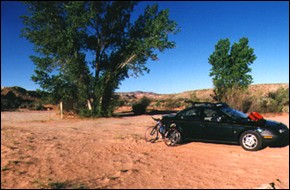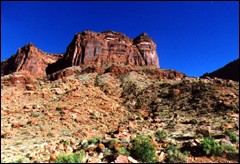

|
|
On the trailhead: Monitor & Merrimac Trail
Photo by M. Scott Smith.
|
Slickrock is good. It’s like the difference between skiing on champagne powder and skiing on, well, typical east coast ice (I mean, “frozen granular.”) Of course, ice is very slick, but you usually don’t mountain bike on ice, and by this point, I’ve forgotten exactly what point I was trying to argue. Oh yes, slickrock is good.
Or so I had heard. I decided to learn firsthand what slickrock is and to see if it’s all it’s cracked up to be.
I headed to Utah, known for its slickrock, and discovered that Utah is also known for being a large desert. As such, some precautions must be taken before heading into the Utah backcountry, be it on hiking boots or on the saddle of a mountain bike.
The desert can be a very unforgiving terrain - especially in the summer, when temperatures regularly exceed 100. It’s recommended that you bring one gallon of water per person per day if you intend to do nothing other than sit in the shade. If you plan to exercise, you may need three gallons or more per day. Caffeinated beverages (such as Coke) don’t count, since caffeine is a diuretic and actually makes you thirstier.
3 gallons is a lot of water, but heat exhaustion is not something to play games with. Cell phones don’t work very well in the backcountry of Utah, and it’s easy to become lost and disoriented. There are mazes of canyons to get lost in. While you may think of deserts as being flat, Utah is very three-dimensional, with many canyons shooting several thousand feet into the air.
Luckily, the temperature was in the mid-80’s when I visited in May, but I still brought plenty of water, along with suntan lotion, a first-aid kit, and plenty of spare tubes for the inevitable flats. I did break one cardinal rule: I went biking alone, which isn’t recommended.
Moab, Utah is located about half an hour south of I-70 in central eastern Utah, near Arches National Park. Whereas mountain biking is frowned upon in many areas of the country, it is a vibrant and heavily supported activity in Moab. Several maintained trails are located throughout the Moab area, offering a wide variety of terrain from easy to extremely challenging.
Perhaps the most famous trail in Moab is the Slickrock Bike Trail. This 9.6-mile trail is technically demanding and strenuous; bikers are encouraged to try out a 2.2-mile “practice loop” before attempting the actual trail. Originally designed as a motorcycle trail, the Slickrock Bike Trail offers a combination of great scenery and challenging terrain. As a first-time Moab biker, I chose not to try out the Slickrock Bike Trail on my first visit, settling instead for the tamer Monitor & Merrimac Trail.
Most of the mountain biking trails around Moab are multiple-use trails, located on land administered by the Bureau of Land Management (BLM). Many trails started as old Jeep roads and mountain bikers should be prepared to share the trails with motor vehicles, pedestrians, and even horses. The Monitor & Merrimac Trail includes terrain ranging from dirt Jeep roads to singletrack to slickrock to dried out (or not-so-dried-out) creek beds. The trail winds through canyons and wraps around plateaus, offering fantastic scenery and complete isolation.
I started my trip around 6:30 a.m., just as the sun was starting to spread its rays. The trailhead is a little difficult to locate; it’s off of an unmarked dirt road just north of highway marker 141 on U.S. 191. (U.S. 191 heads south from I-70 and makes its way to Moab. The Monitor & Merrimac Trail is north of the main entrance to Arches National Park. If you have a GPS receiver, punch in the coordinates in the table above to quickly guide yourself to the trailhead.) After loading up my bike with water and supplies, I was off, pedaling along a bumpy and sandy 4-wheel drive trail across open desert.

|
|
Utah is not flat.
Photo by M. Scott Smith.
|
The terrain changes as you pass through a gap between Courthouse Rock and MillCourthouse Mesa. After a sandy climb, you’ll reach slickrock, which will be your “pavement” for the next several miles. Slickrock is very smooth rock, and a pleasure to ride on. Your ride will be smoother if you have front or full suspension, as there are plenty of bumps. Periodic white dashes painted onto the slickrock mark the trail.
After several miles, you’ll be given a chance to ride out to the Monitor and Merricam buttes, or loop back to the trailhead. On the way back, you’ll pass the Mill Canyon Dinosaur Trail. This is a hiking-only trail, so you’ll need to leave your bike at the trailhead. This short trail leads to an “open air museum,” which showcases fossils and dinosaur bones showing in rock. Plenty of lizards scurried away as I hiked this trail.
A short ride through open desert will take you back to the trailhead.
Without a doubt, my Moab experience was the most exciting time I have had on a mountain bike. In fact, biking seemed more enjoyable than hiking, as I was able to see more beautiful scenery in a shorter amount of time. Riding on the slickrock was like taking a roller coaster ride through the rugged beauty of the Utah backcountry. At one point, the scenery and desolation led me to yell out a line from the movie Titanic - “I’m the king of the world!” (Thankfully, only a few startled birds heard me.)
If you have never been to Utah, one thing that will immediately strike you is the immense vastness of the terrain. You can often see hundreds of miles into the distance, and with low humidity, the heat isn’t too unbearable and nights become quite cool.
There really is a vibrant community of mountain bikers in Moab, and cars adorned with mountain bikes had license plates from across the country, depicting the national appeal of this area. Lodging in Moab is pretty cheap: if you don’t mind sleeping under a canvas of a few thousand stars, you’ll find plenty of inexpensive campsites, or you can pitch a tent in the backcountry. I camped in a canyon just south of Arches National Park, a couple dozen feet from the Colorado River. The showcase of stars and occasional meteors made it difficult to sleep, although the soothing flow and gurgling of the Colorado River soon put me to sleep. For those who would rather sleep in a bed, there are plenty of inexpensive hotels near the Moab area.
So, does Moab deserve its reputation as a mountain biking mecca? From my experience, yes. I wish I had more time to explore the Utah backcountry during my visit, and know that there are plenty of adventures waiting for future visits. And one thing’s certain: I intend to return to Utah many times.
M. Scott Smith is the founder and Editor of DCSki. Scott loves outdoor activities such as camping, hiking, kayaking, skiing, and mountain biking. He is an avid photographer and writer.

There are no reader comments on this article yet.

Join the conversation by logging in.
Don't have an account? Create one here.